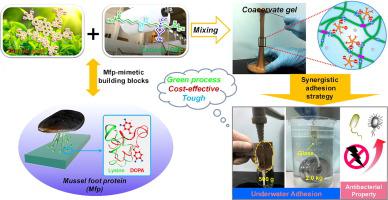Chemical Engineering Journal ( IF 13.3 ) Pub Date : 2020-09-21 , DOI: 10.1016/j.cej.2020.127069 Zhong Wang , Shifeng Zhang , Shujun Zhao , Haijiao Kang , Zhongkai Wang , Changlei Xia , Yanglun Yu , Jianzhang Li

|
Bioinspired underwater adhesives with tough and stable performance are increasingly in demand for biomedical and engineering applications. However, the current methods of synthesizing them usually require sophisticated chemical conjugation or modification and expensive adhesive building blocks. Here, by taking advantage of the catecholic and polyelectrolyte features of mussel foot proteins, we report a facile yet powerful strategy to the development of a strong and cost-effective self-coacervating adhesive based on a coacervation-induced adhesion mechanism. The adhesive comprises a low-cost, commercially available cationic polyelectrolyte—polyamidoamine-epichlorohydrin (PAE)—that is crosslinked in situ by naturally occurring dendritic molecules of tannic acid (TA). A complex coacervate gel (TAPA) is formed after directly mixing pyrogallol-containing TA with PAE polycation. With the gel matrix serving as a robust adhesive when applied underwater to various substrates owing to its synergistic azetidinium–phenolic electrostatic and hydrogen bonding interactions. Compared to previously reported catechol-based adhesives, the polyesters coacervate gel has a widely tunable underwater adhesive strength (50.8 ± 6.8 to 604.8 ± 9.5 kPa) in in wide ranges of pH (3−11) and ionic strength (0−1 M NaCl) and reusable adhesion (<10 cycles). This adhesive strength increases substantially in basic conditions (pH > 9), which trigger the self-crosslinking of PAE chains. By synergistically combining electrostatic adsorption and macroscopic- scale interactions, the incorporated nanocellulose fillers further contribute to the strong cohesion of coacervate adhesives. The easy-to-prepare TAPA adhesive also has excellent antibacterial activity. This in-situ formation strategy opens an innovative and facile route to mimic the self-coacervation and adhesion stability of biomimetic source, leading to a multifunctional underwater bonding solution for biological/engineering adhesive applications.
中文翻译:

单宁酸和聚阳离子的简易仿生自凝聚:水下胶粘剂的韧性和宽pH范围
具有坚韧和稳定性能的受生物启发的水下粘合剂对生物医学和工程应用的需求日益增长。然而,目前合成它们的方法通常需要复杂的化学共轭或修饰以及昂贵的粘合剂构件。在这里,我们利用贻贝足蛋白的幼稚和聚电解质特性,报道了一种简便而有效的策略,可基于凝聚诱导的粘附机理开发出一种坚固且具有成本效益的自凝聚粘合剂。该粘合剂包括一种低成本的可商购的阳离子聚电解质-聚酰胺胺-表氯醇(PAE)-原位交联天然存在的丹宁酸(TA)的树枝状分子。将含邻苯三酚的TA与PAE聚阳离子直接混合后,形成复合凝聚凝胶(TAPA)。由于其具有协同作用的氮杂环丁烷-酚静电和氢键相互作用,当在水下应用于各种基材时,该凝胶基质可作为牢固的粘合剂。与以前报道的基于邻苯二酚的粘合剂相比,聚酯凝聚层凝胶在很宽的pH值(3-11)和离子强度(0-1 M NaCl)范围内具有广泛可调的水下粘合强度(50.8±6.8至604.8±9.5 kPa)。 )和可重复使用的粘合力(<10个循环)。在碱性条件(pH> 9)下,这种粘合强度会大大提高,这会触发PAE链的自交联。通过协同结合静电吸附和宏观相互作用,掺入的纳米纤维素填料进一步有助于凝聚层粘合剂的强大内聚力。易于制备的TAPA粘合剂还具有出色的抗菌活性。这个原位形成策略为模仿仿生源的自我凝聚和粘附稳定性开辟了一条创新且便捷的途径,从而为生物/工程粘合剂应用提供了多功能水下粘合解决方案。











































 京公网安备 11010802027423号
京公网安备 11010802027423号